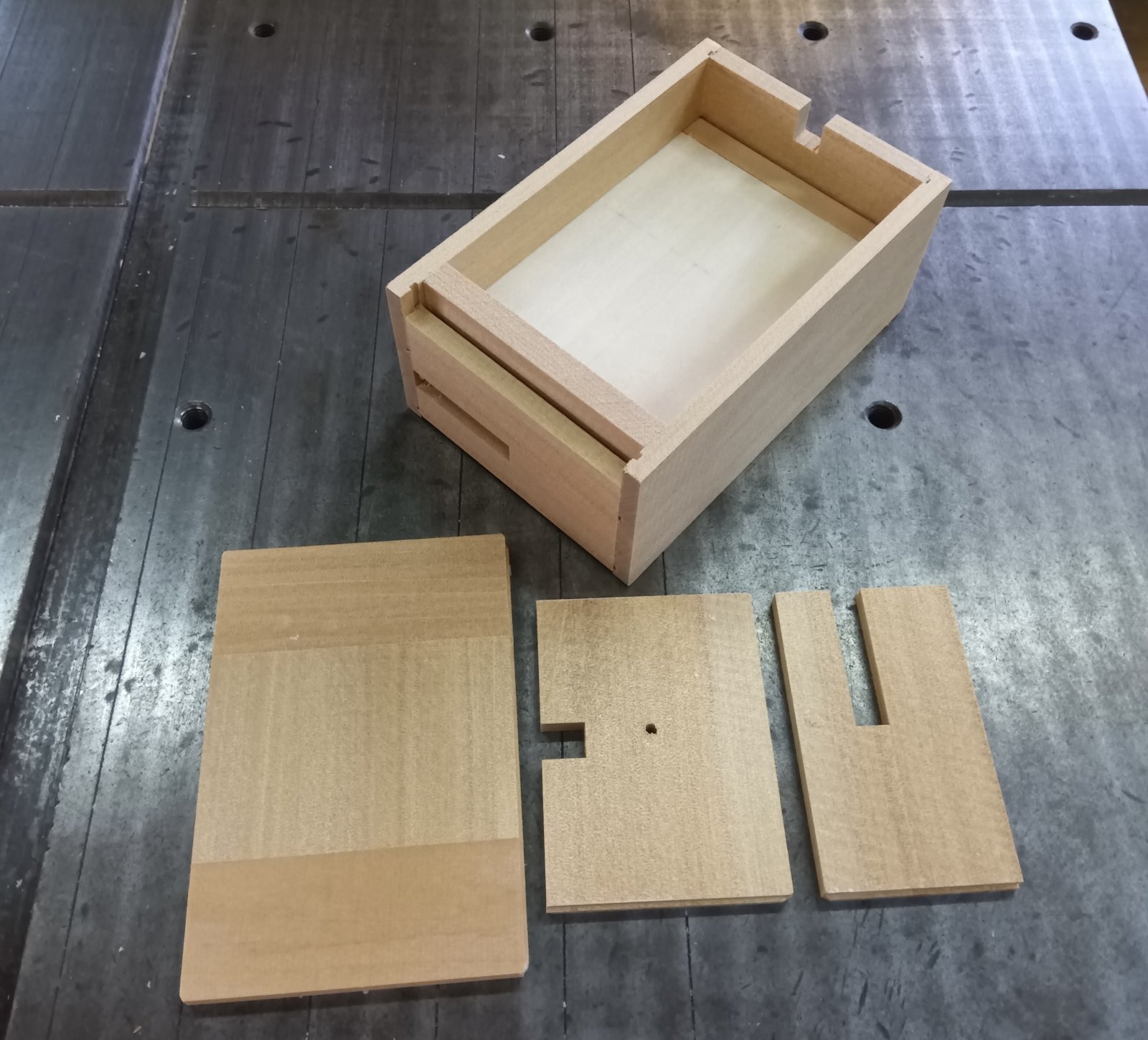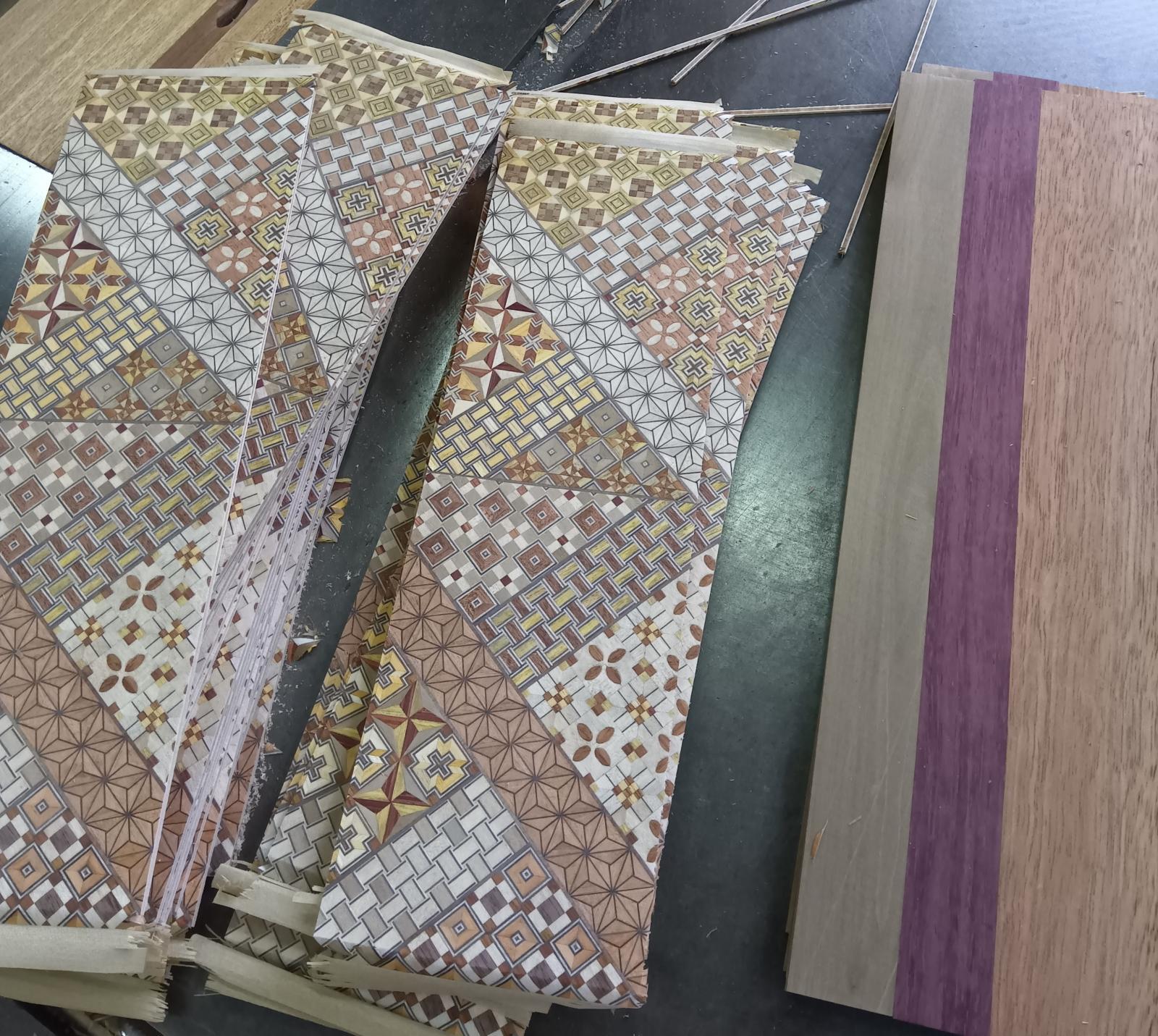5 sun Drawer box (3)
Last weekend, I didn't make significant progress on the 5-sun Drawer Japanese puzzle box; only the 'aruki' mechanism was attached. Today, I plan to create and attach the top and bottom panels as the initial process.
As shown in the photo, this box uses three "aruki" panels. Since this is a 5-sun size box, the aruki panel on the top lid is crafted using a method called "Hashibami," where a single aruki is made from three separate pieces. This technique involves crossing the wood grains to prevent large panels from warping. The aruki panels in a puzzle box are not glued to the box body but instead slide within grooves, which makes them prone to warping. To prevent this, the wood grains are arranged in a way that resists warping in all directions. The "Hashibami" method is used for boxes sized 5-sun and above. You can also see a space in the center of the main body, where the drawer will be stored.The drawer is made separately and will be set in place at the very end.
and Unlike the usual puzzle boxes, one of the side panels features a distinctive aruki panel.The aruki panel with the hole in the center, visible in the photo, is the one that moves at the 8th step before the drawer is revealed. The square cut-out at the bottom is designed to accommodate the handle of the drawer, which is a small cylindrical protrusion. Additionally, the small hole in the center is for attaching a round pin, about 3mm thick, to prevent the 8th-step aruki panel from falling out. The panel is carefully crafted so that it slides just enough to match the drawer's height and stops there. The axis board on the side of this aruki also has a groove that allows the pin to move and lock in place, with the groove’s length precisely calculated for the correct fit.
This pin mechanism is something I developed on my own. In the past, the 8th-step mechanism was different. While the groove was still there, it didn't use a pin. Instead, the groove would stop halfway, preventing the protrusion from advancing further and stopping the aruki. It's a bit tricky to explain, but it's similar to the structure used in my Mame puzzle boxes, where the aruki panels are prevented from falling out by a similar mechanism.
As I mentioned previously, most of the current production features traditional yosegi designs, but I'm also making four pieces with a natural wood finish. Instead of using many types of wood as usual, I kept the design simple, using only Nyatoh, Hoo, and Purple-heart wood. While it's not visible in the current photos, the natural wood side panels, which will be attached in the coming days, are made from Nyatoh and Hoo wood. These materials were originally intended for the 6-sun box I was working on in August. However, that box had a 54-step mechanism with four sliding keys on the sides (eight keys in total), and I realized that using two different types of natural wood could cause potential issues in the production process. So, I decided to stop using that materials and am now repurposing the materials for this 5-sun box.
This has gotten a bit long, so I'll stop here for today😊 I’ll write more once the production progresses further.
As shown in the photo, this box uses three "aruki" panels. Since this is a 5-sun size box, the aruki panel on the top lid is crafted using a method called "Hashibami," where a single aruki is made from three separate pieces. This technique involves crossing the wood grains to prevent large panels from warping. The aruki panels in a puzzle box are not glued to the box body but instead slide within grooves, which makes them prone to warping. To prevent this, the wood grains are arranged in a way that resists warping in all directions. The "Hashibami" method is used for boxes sized 5-sun and above. You can also see a space in the center of the main body, where the drawer will be stored.The drawer is made separately and will be set in place at the very end.
and Unlike the usual puzzle boxes, one of the side panels features a distinctive aruki panel.The aruki panel with the hole in the center, visible in the photo, is the one that moves at the 8th step before the drawer is revealed. The square cut-out at the bottom is designed to accommodate the handle of the drawer, which is a small cylindrical protrusion. Additionally, the small hole in the center is for attaching a round pin, about 3mm thick, to prevent the 8th-step aruki panel from falling out. The panel is carefully crafted so that it slides just enough to match the drawer's height and stops there. The axis board on the side of this aruki also has a groove that allows the pin to move and lock in place, with the groove’s length precisely calculated for the correct fit.
This pin mechanism is something I developed on my own. In the past, the 8th-step mechanism was different. While the groove was still there, it didn't use a pin. Instead, the groove would stop halfway, preventing the protrusion from advancing further and stopping the aruki. It's a bit tricky to explain, but it's similar to the structure used in my Mame puzzle boxes, where the aruki panels are prevented from falling out by a similar mechanism.
As I mentioned previously, most of the current production features traditional yosegi designs, but I'm also making four pieces with a natural wood finish. Instead of using many types of wood as usual, I kept the design simple, using only Nyatoh, Hoo, and Purple-heart wood. While it's not visible in the current photos, the natural wood side panels, which will be attached in the coming days, are made from Nyatoh and Hoo wood. These materials were originally intended for the 6-sun box I was working on in August. However, that box had a 54-step mechanism with four sliding keys on the sides (eight keys in total), and I realized that using two different types of natural wood could cause potential issues in the production process. So, I decided to stop using that materials and am now repurposing the materials for this 5-sun box.
This has gotten a bit long, so I'll stop here for today😊 I’ll write more once the production progresses further.

